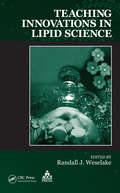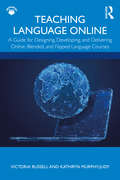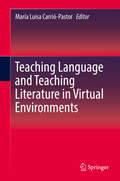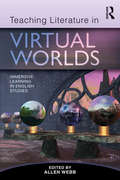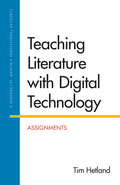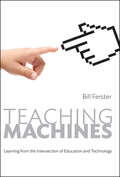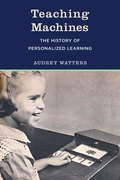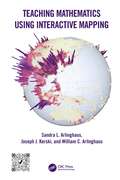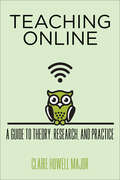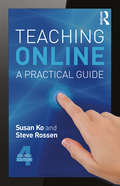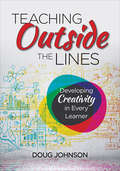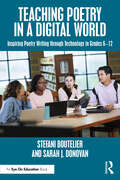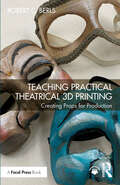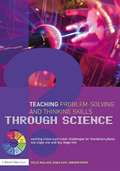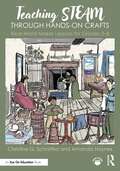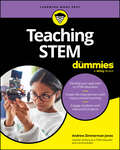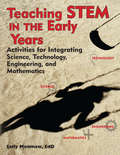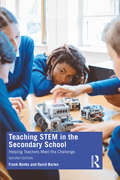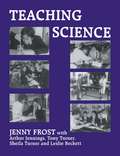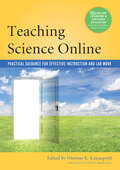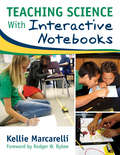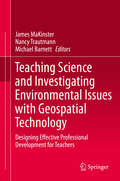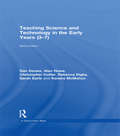- Table View
- List View
Teaching Innovations in Lipid Science
by Randall J. WeselakeFeaturing practical strategies and exciting experiments, Teaching Innovations in Lipid Science addresses lipid education at a range of levels from the novice to the graduate student and teacher. Peer-reviewed contributions from internationally known specialists, describe several methods and approaches designed to create new lipid courses, mo
Teaching Language Online: A Guide for Designing, Developing, and Delivering Online, Blended, and Flipped Language Courses
by Victoria Russell Kathryn Murphy-JudyPractical and accessible, this book comprehensively covers everything you need to know to design, develop, and deliver successful online, blended, and flipped language courses. Grounded in the principles of instructional design and communicative language teaching, this book serves as a compendium of best practices, research, and strategies for creating learner-centered online language instruction that builds students’ proficiency within meaningful cultural contexts. This book addresses important topics such as finding and optimizing online resources and materials, learner engagement, teacher and student satisfaction and connectedness, professional development, and online language assessment. Teaching Language Online features: A step-by-step guide aligned with the American Council on the Teaching of Foreign Languages (ACTFL), the Common European Framework of Reference (CEFR) for Languages: Learning, Teaching and Assessment, and the World-Class Instructional Design and Assessment (WIDA) standards Research-based best practices and tools to implement effective communicative language teaching (CLT) online Strategies and practices that apply equally to world languages and ESL/EFL contexts Key takeaway summaries, discussion questions, and suggestions for further reading in every chapter Free, downloadable eResources with further readings and more materials available at www.routledge.com/ 9781138387003 As the demand for language courses in online or blended formats grows, K-16 instructors urgently need resources to effectively transition their teaching online. Designed to help world language instructors, professors, and K-12 language educators regardless of their level of experience with online learning, this book walks through the steps to move from the traditional classroom format to effective, successful online teaching environments.
Teaching Language and Teaching Literature in Virtual Environments
by María Luisa Carrió-PastorThis book sheds new light on language and literature teaching, and offers examples of teaching language in virtual environments. Providing an overview of virtual environments for teaching, it also includes chapters devoted to methodology design for second language teaching in these environments. Further it describes tools for second/ foreign language teaching and proposals for specific second language teaching in virtual environments. Lastly, it presents experiments on literature teaching in virtual environments and discusses the future of technology in education. With interdisciplinary appeal, the book is a particularly valuable resource for scholars with an interest in technology, language teaching and literature teaching.
Teaching Literature in Virtual Worlds: Immersive Learning in English Studies
by Allen WebbWhat are the realities and possibilities of utilizing on-line virtual worlds as teaching tools for specific literary works? Through engaging and surprising stories from classrooms where virtual worlds are in use, this book invites readers to understand and participate in this emerging and valuable pedagogy. It examines the experience of high school and college literature teachers involved in a pioneering project to develop virtual worlds for literary study, detailing how they created, utilized, and researched different immersive and interactive virtual reality environments to support the teaching of a wide range of literary works. Readers see how students role-play as literary characters, extending and altering character conduct in purposeful ways ,and how they explore on-line, interactive literature maps, museums, archives, and game worlds to analyze the impact of historical and cultural setting, language, and dialogue on literary characters and events. This book breaks exciting ground, offering insights, pedagogical suggestions, and ways for readers to consider the future of this innovative approach to teaching literary texts.
Teaching Literature with Digital Technology Assignments
by Tim HetlandTeaching Literature with Digital Technology is a collection of digital assignments, each created by a contributor in the fields of literature and composition. Edited by Seattle-based scholar and teacher Tim Hetland and available as a print text or PDF e-book, this resource for instructors invites students to become knowledge-makers as it introduces creative uses of social media, digital tools, podcasts, multimodal assignments, and digital archives to learn about literature. Sample assignments can be viewed in the Professional Resources folder on the Macmillan English Community site. To order the print text, use ISBN: 978-1-4576-2948-8; to order a PDF e-book of the text, use ISBN: 978-1-3190-7643-6.
Teaching Machines: Learning from the Intersection of Education and Technology (Tech.edu: A Hopkins Series on Education and Technology)
by Bill FersterTechnology promises to make learning better, cheaper, faster—but rarely has it kept that promise.The allure of educational technology is easy to understand. Classroom instruction is an expensive and time-consuming process fraught with contradictory theories and frustratingly uneven results. Educators, inspired by machines’ contributions to modern life, have been using technology to facilitate teaching for centuries.In Teaching Machines, Bill Ferster examines past attempts to automate instruction from the earliest use of the postal service for distance education to the current maelstrom surrounding Massive Open Online Courses. He tells the stories of the entrepreneurs and visionaries who, beginning in the colonial era, developed and promoted various instructional technologies. Ferster touches on a wide range of attempts to enhance the classroom experience with machines, from hornbooks, the Chautauqua movement, and correspondence courses to B. F. Skinner’s teaching machine, intelligent tutoring systems, and eLearning. The famed progressive teachers, researchers, and administrators that the book highlights often overcame substantial hurdles to implement their ideas, but not all of them succeeded in improving the quality of education. Teaching Machines provides invaluable new insight into our current debate over the efficacy of educational technology.
Teaching Machines: The History of Personalized Learning
by Audrey WattersHow ed tech was born: Twentieth-century teaching machines--from Sidney Pressey's mechanized test-giver to B. F. Skinner's behaviorist bell-ringing box.Contrary to popular belief, ed tech did not begin with videos on the internet. The idea of technology that would allow students to "go at their own pace" did not originate in Silicon Valley. In Teaching Machines, education writer Audrey Watters offers a lively history of predigital educational technology, from Sidney Pressey's mechanized positive-reinforcement provider to B. F. Skinner's behaviorist bell-ringing box. Watters shows that these machines and the pedagogy that accompanied them sprang from ideas--bite-sized content, individualized instruction--that had legs and were later picked up by textbook publishers and early advocates for computerized learning. Watters pays particular attention to the role of the media--newspapers, magazines, television, and film--in shaping people's perceptions of teaching machines as well as the psychological theories underpinning them. She considers these machines in the context of education reform, the political reverberations of Sputnik, and the rise of the testing and textbook industries. She chronicles Skinner's attempts to bring his teaching machines to market, culminating in the famous behaviorist's efforts to launch Didak 101, the "pre-verbal" machine that taught spelling. (Alternate names proposed by Skinner include "Autodidak," "Instructomat," and "Autostructor.") Telling these somewhat cautionary tales, Watters challenges what she calls "the teleology of ed tech"--the idea that not only is computerized education inevitable, but technological progress is the sole driver of events.
Teaching Mathematics Using Interactive Mapping
by Joseph J. Kerski Sandra L. Arlinghaus William C. ArlinghausTeaching Mathematics Using Interactive Mapping offers novel ways to learn basic math topics such as simple relational measures or measuring hierarchies through customized interactive mapping activities. These activities focus on interactive web-based Geographic Information System (GIS) and are relevant to today’s problems and challenges. Written in a guided, hands-on, understandable manner, all activities are designed to build practical and problem-solving skills that rest on mathematical principles and move students from thinking about maps as references that focus solely on "where is" something, to analytical tools, focusing primarily on the "whys of where." Success with this transition through interaction permits most readers to master mathematical concepts and GIS tools. FEATURES Offers custom-designed geographical activities to fit with specific mathematical topics Helps students become comfortable using mathematics in a variety of professions Provides an innovative, engaging, and practical set of activities to ease readers through typically difficult, often elementary, mathematical topics: fractions, the distributive law, and much more Uses web-based GIS maps, apps, and other tools and data that can be accessed on any device, anywhere, at any time, requiring no prior GIS background Written by experienced teachers and researchers with lifelong experience in teaching mathematics, geography, and spatial analysis This textbook applies to undergraduate and graduate students in universities and community colleges including those in basic mathematics courses, as well as upper-level undergraduate and graduate students taking courses in geographic information systems, remote sensing, photogrammetry, geography, geodesy, information science, engineering, and geology. Professionals interested in learning techniques and technologies for collecting, analyzing, managing, processing, and visualizing geospatial datasets will also benefit from this book as they refresh their knowledge in mathematics.
Teaching Online: A Guide to Theory, Research, and Practice (Tech.edu: A Hopkins Series on Education and Technology)
by Claire Howell MajorDemystifies online teaching for both enthusiastic and wary educators and helps faculty who teach online do their best work as digital instructors.It is difficult to imagine a college class today that does not include some online component—whether a simple posting of a syllabus to course management software, the use of social media for communication, or a full-blown course offering through a MOOC platform. In Teaching Online, Claire Howell Major describes for college faculty the changes that accompany use of such technologies and offers real-world strategies for surmounting digital teaching challenges.Teaching with these evolving media requires instructors to alter the ways in which they conceive of and do their work, according to Major. They must frequently update their knowledge of learning, teaching, and media, and they need to develop new forms of instruction, revise and reconceptualize classroom materials, and refresh their communication patterns. Faculty teaching online must also reconsider the student experience and determine what changes for students ultimately mean for their own work and for their institutions. Teaching Online presents instructors with a thoughtful synthesis of educational theory, research, and practice as well as a review of strategies for managing the instructional changes involved in teaching online. In addition, this book presents examples of best practices from successful online instructors as well as cutting-edge ideas from leading scholars and educational technologists. Faculty members, researchers, instructional designers, students, administrators, and policy makers who engage with online learning will find this book an invaluable resource.
Teaching Online: A Practical Guide (College Teaching Ser.)
by Susan Ko Steve RossenTeaching Online: A Practical Guide is an accessible, introductory, and comprehensive guide for anyone who teaches online. The fourth edition of this bestselling resource has been fully revised, maintains its reader-friendly tone, and offers exceptional practical advice, new teaching examples, faculty interviews, and an updated resource section. New to this edition: entire new chapter on MOOCs (massive open online courses); expanded information on teaching with mobile devices, using open educational resources, and learning analytics; additional interviews with faculty, case studies, and examples; spotlight on new tools and categories of tools, especially multimedia. Focusing on the "hows" and "whys" of implementation rather than theory, the fourth edition of Teaching Online is a must-have resource for anyone teaching online or thinking about teaching online.
Teaching Outside the Lines: Developing Creativity in Every Learner
by Douglas A. JohnsonMake Creativity The Center Of The Curriculum! In our fast-changing world, the ability to think independently and innovatively is no longer a “nice extra”—it’s a survival skill. This book delivers surefire strategies for equipping learners across all grades and subjects with the motivation and critical thinking skills to thrive in our high-tech future. Content includes: Why “one right answer” instruction paradigms discourage critical thinking and risk-taking Why merely using the latest technology class does not equate to teaching creatively Projects and prompts that ask the question “So what does this mean in the classroom today?”
Teaching Outside the Lines: Developing Creativity in Every Learner
by Douglas A. JohnsonMake Creativity The Center Of The Curriculum! In our fast-changing world, the ability to think independently and innovatively is no longer a “nice extra”—it’s a survival skill. This book delivers surefire strategies for equipping learners across all grades and subjects with the motivation and critical thinking skills to thrive in our high-tech future. Content includes: Why “one right answer” instruction paradigms discourage critical thinking and risk-taking Why merely using the latest technology class does not equate to teaching creatively Projects and prompts that ask the question “So what does this mean in the classroom today?”
Teaching Poetry in a Digital World: Inspiring Poetry Writing through Technology in Grades 6-12
by Stefani Boutelier Sarah J. DonovanTeaching Poetry in a Digital World supports English language arts (ELA) educators for grades 6–12 to incorporate digital literacy in their classrooms by teaching the reading and writing of poetry.In an increasingly digital age, educators must adapt to meet the changing needs and interests of their students by incorporating technology into the classroom. This book introduces its audience to the e-Poetry Framework. This framework demonstrates how poetry might present itself in a literacy-based unit with the benefit of a technology medium to share with the world. Examples include teaching zip-ode poetry, incorporating haiku with the creation of GIFs, and ethically discussing AI with nonet poems. With adaptable lesson plans and assessments, as well as educator examples, the book will inspire teachers to create intentional student-centered e-Poetry units.The book is aligned with ELA literacy standards, International Society for Technology in Education (ISTE) educator standards, and National Council of Teachers of English (NCTE)’s position statement for integrating technology into ELA classrooms. It is a key resource for secondary school educators teaching ELA, creative writing, and digital media.
Teaching Practical Theatrical 3D Printing: Creating Props for Production
by Robert C. BerlsTeaching Practical Theatrical 3D Printing: Creating Props for Production is a cohesive and practical guide for instructors teaching 3D printing techniques in stagecraft, costume and props courses.Written for the instructor, this book uses non-technical language to explain 3D printers, their workflows and products. Coverage includes the ins and outs of multiple filaments, pros and cons of different types of printers, shop or laboratory setup and safety concerns. The book features lesson plans, rubrics and class-tested sample student projects from design to finished product that highlight learning objectives and methodologies, as well as software and hardware usage explanations and common problems that can occur within design and printing. Step-by-step instructions are included for many types of projects, including fake noses, candlestick phones, buttons, 3D scans, historical recreations and linear actuators. The book also contains examples of poor, average and excellent work with grading explanations and guidance on how to help the student move to the next level with their projects. Chapter objectives, chapter summaries, checklists and reflection points facilitate an instructor in gaining confidence with 3D printers and incorporating their use in the classroom.Teaching Practical Theatrical 3D Printing is an excellent resource for instructors of Props and Costume Design and Construction courses that are interested in using state of the art tools and technology for theatre production.Fully editable files for every object featured in the book are available at www.routledge.com/9781032453279, allowing readers to jump-start their projects and giving them the flexibility to change and redesign the items to best fit their needs.
Teaching Problem-Solving and Thinking Skills through Science: Exciting Cross-Curricular Challenges for Foundation Phase, Key Stage One and Key Stage Two
by Andrew Berry Belle Wallace Diana CaveThis highly practical resource book presents ways in which teachers can help to develop children's problem-solving and thinking skills through a range of exciting science topics. The book contains classroom-based activities which have been trialled and evaluated by teachers and children, and helpfully shows how the skills developed through rigorous scientific investigations can be used across all areas of the curriculum. The scientific curriculum requirements are extended with exciting and inspiring problem-solving activities that use scientific skills, for example: fair-testing pattern-seeking surveying classifying and identifying investigations over time designing testing and adapting an artefact open-ended exploration The book contains learning objectives for each activity, step by step guidelines for carrying out each problem-solving activity, basic equipment that's needed, examples of learner's work and guidelines for assessment. This book is a must-buy for all early years and primary school teachers keen to encourage an inclusive but differentiated approach to the development of problem-solving and thinking skills in their pupils.
Teaching STEAM Through Hands-On Crafts: Real-World Maker Lessons for Grades 3-8
by Amanda Haynes Christine G. SchnittkaHelp your students connect historic technologies with today’s STEAM concepts through the lens of crafting! This book, written by a science education professor and a middle school STEM teacher, provides guidance for turning classic crafts into transdisciplinary STEAM lessons for grades 3–8. Ready-to-use lessons outline the history, science, mathematics, and engineering embedded within ten hands-on crafts from around the world. Each chapter outlines the history of a craft, its social impact, and the mathematics, engineering, and scientific concepts and skills embedded in the craft. Content standards from art, history, English language arts, technology, mathematics, and science are embedded within each unit. Lessons are supplemented with ready-to-photocopy handouts, guiding questions, and logistical support such as shopping lists and safety procedures. Activities have all been classroom-tested to ensure appropriate leveling and applicability across STEAM disciplines. Ideal for any STEM or STEAM classroom across upper elementary and middle schools, this book helps make STEM concepts meaningful and tangible for your students. Rather than just reading about science, technology, mathematics, or engineering, students will become makers and engage in STEAM directly, just as original crafters have done for centuries.Additional instructional materials are available at: https://steamcrafts.weebly.com/
Teaching STEM For Dummies
by Andrew Zimmerman JonesSpark a passion for STEM Teaching STEM For Dummies is an easy-to-read and exciting new guide for teachers who want to inspire their students with engaging lessons and thoughtful discussions about science, technology, engineering, and mathematics. This practical roadmap to developing hands-on classroom material relevant to the real world shows you how to define STEM topics and overcome the most common challenges to teaching these complex subjects to younger students. You'll learn how you can make STEM more welcoming—using inclusion, scaffolding, and differentiation—and discover resources for STEM teachers you can deploy immediately in your classroom. Inside the book: Understand the STEM concepts students are expected to learn at different grades and how to connect those ideas together in engaging lessons Teach your students the inquisitive mindsets, logical reasoning, and collaboration skills they'll need to succeed in STEM fields Increase STEM inclusivity in both the classroom and the industry by engaging all students in STEM from early ages Discover resources to educate students on the problem-solving concepts at the core of STEM subjects Perfect for teachers, homeschooling parents, tutors, and other educators, Teaching STEM For Dummies is a can't-miss read for anyone who wants to open young minds to the wonders of STEM.
Teaching STEM in the Early Years
by Sally MoomawThe foundation for science, technology, engineering, and mathematics (STEM) education begins in the early years. This book provides more than ninety activities and learning center ideas that seamlessly integrate STEM throughout early childhood classrooms. These hands-on STEM experiences enhance cooking, art, and music activities, block play and sensory table exploration, and field trips and outdoor time. Information on assessment and early learning standards is also provided.Sally Moomaw, EdD, has spent much of her career researching and teaching STEM education. She is an assistant professor at the University of Cincinnati and the author of several early education books.
Teaching STEM in the Secondary School: Helping Teachers Meet The Challenge
by David Barlex Frank BanksThis book looks at the purpose and pedagogy of STEM teaching and explores the ways in which STEM subjects can interact in the curriculum to enhance student understanding, achievement and motivation. By reaching outside their own classroom, teachers can collaborate across STEM subjects to enrich learning and help students relate school science, technology and maths to the wider world. Packed with ideas and practical details for teachers of STEM subjects, the new revised edition of this book: ■ considers what the STEM subjects contribute separately to the curriculum and how they relate to each other in the wider education of secondary school students; ■ describes and evaluates different curriculum models for STEM; ■ suggests ways in which a critical approach to the pedagogy of the classroom, laboratory and workshop can support and encourage all pupils to engage fully in STEM; ■ addresses the practicalities of introducing, organising and sustaining STEM-related activities in the secondary school; ■ looks to ways schools can manage and sustain STEM approaches in the long-term. This new revised edition is essential reading for trainee and practising teachers, those engaged in further professional development and all who wish to make the learning of science, technology, engineering and mathematics an interesting, motivating and exciting experience for their students.
Teaching Science
by Jenny Frost Richard B. IngleFirst published in 1995. Routledge is an imprint of Taylor & Francis, an informa company.
Teaching Science (Developing as a Reflective Secondary Teacher)
by Judith Thomas Matt Cochrane Mr Bernard Kerfoot Dr Tony LiversidgeReflective practice is at the heart of effective teaching, and this book helps you develop into a reflective teacher of Science. Everything you need is here: guidance on developing your analysis and self-evaluation skills, the knowledge of what you are trying to achieve and why, and examples of how experienced teachers deliver successful lessons. It includes advice about obtaining your first teaching post, and about continuing professional development. The book shows you how to plan creative lessons, how to make good use of resources and how to assess pupils' progress effectively. Each chapter contains points for reflection, which encourage you to break off from your reading and think about the challenging questions that you face as a new teacher. The book comes with access to a companion website, www.sagepub.co.uk/secondary, where you will find: - Videos of real lessons so you can see the skills discussed in the text in action - Links to a range of sites that provide useful additional support - Extra planning and resource materials. If you are training to teach science this book will help you to improve your classroom performance, by providing you with practical advice, but also by helping you to think in depth about the key issues. It also supplements guidance on undertaking a research project with examples of the research evidence that is needed in academic work at Masters level, essential for anyone undertaking an M-level PGCE.
Teaching Science Online: Practical Guidance for Effective Instruction and Lab Work
by Dietmar K. KennepohlWith the increasing focus on science education, growing attention is being paid to how science is taught. Educators in science and science-related disciplines are recognizing that distance delivery opens up new opportunities for delivering information, providing interactivity, collaborative opportunities and feedback, as well as for increasing access for students. This book presents the guidance of expert science educators from the US and from around the globe. They describe key concepts, delivery modes and emerging technologies, and offer models of practice. The book places particular emphasis on experimentation, lab and field work as they are fundamentally part of the education in most scientific disciplines. Chapters include:* Discipline methodology and teaching strategies in the specific areas of physics, biology, chemistry and earth sciences.* An overview of the important and appropriate learning technologies (ICTs) for each major science.* Best practices for establishing and maintaining a successful course online.* Insights and tips for handling practical components like laboratories and field work.* Coverage of breaking topics, including MOOCs, learning analytics, open educational resources and m-learning.* Strategies for engaging your students online.
Teaching Science With Interactive Notebooks
by Kellie MarcarelliIncrease student learning in the inquiry-based science classroom! Interactive notebooks allow students to record observations, reflect on learning, and self-assess their work. Packed with student examples, this detailed guide explains the unique features that make interactive notebooks more effective tools than conventional notebooks for science classrooms. This resource: Describes the nuts and bolts of implementing interactive notebooks, including execution, time management, and grading Uses the 5E Learning Cycle as the framework for science instruction Emphasizes the importance of writing in science and provides strategies for modeling effective writing Explores strategies to encourage collaborative student inquiry and foster whole-class discussions
Teaching Science and Investigating Environmental Issues with Geospatial Technology
by Michael Barnett Nancy Trautmann James MakinsterThe emerging field of using geospatial technology to teach science and environmental education presents an excellent opportunity to discover the ways in which educators use research-grounded pedagogical commitments in combination with their practical experiences to design and implement effective teacher professional development projects. Often missing from the literature are in-depth, explicit discussions of why and how educators choose to provide certain experiences and resources for the teachers with whom they work, and the resulting outcomes. The first half of this book will enable science and environmental educators to share the nature and structure of large scale professional development projects while discussing the theoretical commitments that undergird their work. Many chapters will include temporal aspects that present the ways in which projects change over time in response to evaluative research and practical experience. In the second half of the book, faculty and others whose focus is on national and international scales will share the ways in which they are working to meet the growing needs of teachers across the globe to incorporate geospatial technology into their science teaching. These efforts reflect the ongoing conversations in science education, geography, and the geospatial industry in ways that embody the opportunities and challenges inherent to this field. This edited book will serve to define the field of teacher professional development for teaching science using geospatial technology. As such, it will identify short term and long term objectives for science, environmental, and geography educators involved in these efforts. As a result, this book will provide a framework for future projects and research in this exciting and growing field.
Teaching Science and Technology in the Early Years (3–7)
by Christopher Collier Dan Davies Alan Howe Sarah Earle Kendra McMahon Rebecca DigbyTeaching Science and Technology in the Early Years (3-7) celebrates young children’s amazing capabilities as scientists, designers and technologists. Research-based yet practical and accessible, it demonstrates how scientific, designing and making activities are natural to young children, and have the potential for contributing to all aspects of their learning. By identifying the scientific and design-related concepts, skills and activities being developed, the book enables the reader to make more focused diagnostic observations of young children and plan for how they can help move them forward in their learning. This second edition has been thoroughly updated and features: Six new chapters providing practical advice and examples for enhancing scientific and technological learning through thematic approaches a new chapter focusing on the outdoor learning environment and how this can support science and technology new case studies of successful early years practice, alongside examples of practical planning for learning, and advice on documenting children’s learning stories, guidance on the role of talk, narrative, documentation and planning in relation to early years science and technology Based on the latest research and the first hand experience, this practical and accessible book is essential reading for early years and primary students on undergraduate and Masters level courses. ? ? ?
